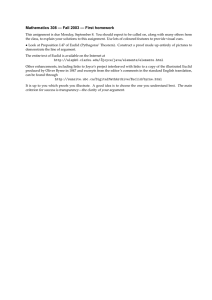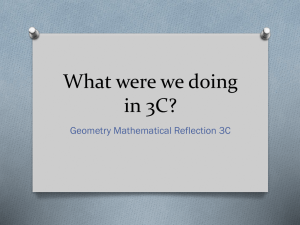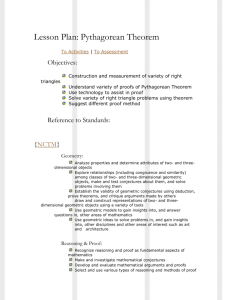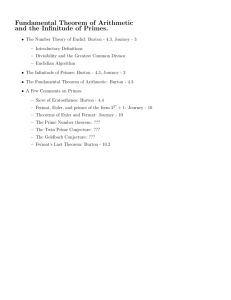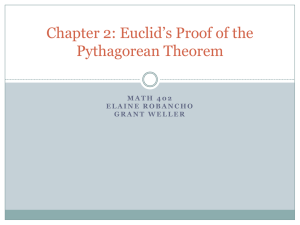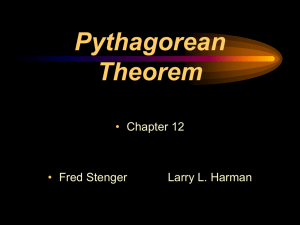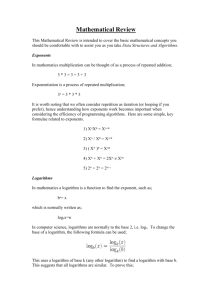Eudoxus (410
advertisement
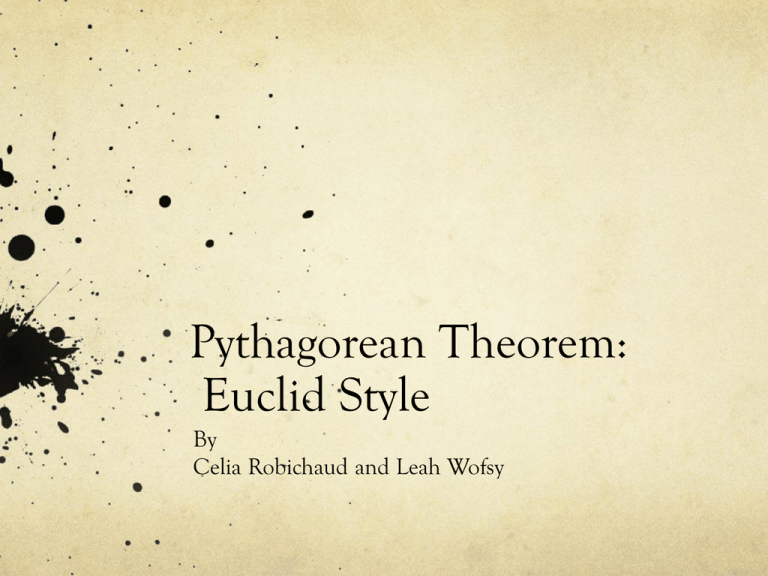
Pythagorean Theorem: Euclid Style By Celia Robichaud and Leah Wofsy Some history before Euclid Plato • Known for his enthusiasm about math and not as much his contributions to the discipline •Socrates was his mentor, Aristotle his student •Founded the Academy in 387 B.C. •“Let no man ignorant of geometry enter here” Alexander the Great •Established Alexandria in 332 B.C. in Egypt Eudoxus (410355 B.C.) • Pupil of Plato at the Academy • Later became one of the greatest and most influential mathematicians and astronomers. • Provided complex explanations of lunar and planetary movement using series of concentric spheres • First to provide mathematical explanation for the movement of planets. A Greek Mathematical View of the Solar System... c.400B.C. • The Sun and Moon had two spheres each, one rotated Westward once every 24 hrs, one Eastward every month, one in the latitudinal direction once per month. •The five known planets each had five spheres explaining their motion. • Eudoxus is remembered for two great theorems, the theory of proportion and the method of exhaustion. •Theory of Proportion: Eudoxus defines the meaning of equality between two proportions, restoring the geometric theorems that had before rested on the fact that any two magnitudes were commensurable (now known to be untrue) Theorem: A/B = C/D iff for all integers m and n whenever mA < nB then mC<nD, similarly for the relations > and = • Found in Book V of the Elements Method of Exhaustion • Allowed mathematicians to determine the areas of more complicated geometric figures, leading to the determination of the area of a circle (Ch.4) •Approach an irregular figure by breaking it down into pieces of known area Euclid: •Euclid came to Alexandria in 300 B.C. to set up school of Mathematics •Wrote the Elements, which today, consists of 13 books •The Elements was based off an axiomatic framework Euclid’s Proof of the Pythagorean Theorem • 300 B.C. • Not an algebraic proof (A2=B2+C2), but a geometric proof (square on the hypotenuse is equal to the squares on the sides containing the right angle. •GA and AC on the same line •Only time in proof that fact <BAC is right is used •Proved slender triangles congruent by SAS •FB and AB equal from construction •BD = BC for same reason •<FBC=<ABD, both=<ABC + 90° • ΔABD and rectangle BDLM share same base and fall within same parallels •Area of BDLM 2x area ofΔABD •Same goes for ΔFBC and ABFG Area BDLM= 2(ΔABD)=2(ΔFBC)=Area ABFG Proved CELM=ACKH same way by drawing AE and BK. Therefore: Area of BCED = BDLM + CELM = ABFG + ACKH Q.E.D. But there’s more than one way to prove a theorem… •There are hundreds of proofs for the Pythagorean Theorem, including one devised by James A. Garfield! Knowing the area of a trapezoid… ½(AB +AB + C2) = ½(B+A)(A+B)=½(A2 + B2 + 2AB) Algebraic Proof A angle and B angle are complementary Blue central shape is a square with area C2 Area of whole shape is 4 (1/2 AB) + C2 Or (A + B) 2 = A2 + 2AB + B2 A2 + 2AB + B2 = 4 (1/2 AB) + C2 C2 = A2 + B2 Converse proof C B E Prove that D A BAC and DAC are congruent CD2 = AD2 + AC2 = AB2 + AC2 = BC2 CD = BC BAC and DAC are congruent by SSS Non-Euclidean Geometry “Alternative” Geometry discovered by Gauss in early 19th C. Maintains that triangles have less than 180° in their angles Reinforced by work of Johann Bolyai and Nicolai Lobachevski Bernhard Reimann, using unbounded but finite lines, also explained a geometric universe where triangles can have more than 180°. Questions to ponder •With so many possible ways to prove Pythagoras’ theorem, why did Euclid choose to prove it with the method that he did? •Why was the work in other disciplines at the time so incorrect but Euclid’s work has stood the test of time?

